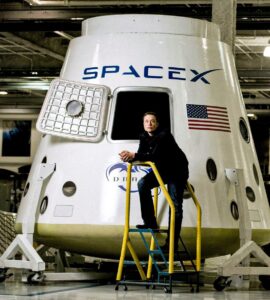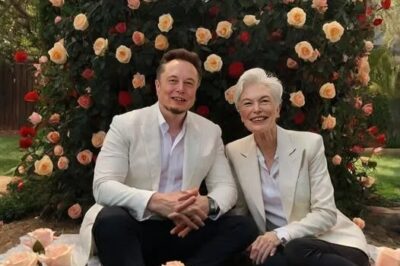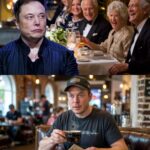Elon Musk, the visionary entrepreneur whose name is synonymous with innovation, didn’t just aim for the stars—he built a company to conquer them. Founded in 2002, SpaceX (Space Exploration Technologies Corp.) has transformed from a risky startup on the brink of failure to a powerhouse revolutionizing space travel. As of August 2025, with over 500 successful Falcon launches and ambitious plans for Mars colonization, Musk’s journey with SpaceX is a testament to relentless ambition, groundbreaking engineering, and the audacity to challenge the impossible. This article chronicles the highs, lows, and pivotal moments that shaped SpaceX into the world’s leading private space company, highlighting Musk’s unyielding drive to make humanity multi-planetary.

The Spark: Musk’s Early Inspirations and Bold Vision
Elon Musk’s fascination with space began long before SpaceX. Born in Pretoria, South Africa, in 1971, Musk was an avid reader of science fiction, devouring works like Isaac Asimov’s Foundation series and Robert Heinlein’s novels. These stories fueled his belief that humanity’s survival depends on becoming a spacefaring civilization. After selling Zip2 for $307 million in 1999 and PayPal for $1.5 billion in 2002, Musk had the capital to pursue his dreams. Frustrated by NASA’s slow pace and the high costs of spaceflight—rockets were disposable and exorbitantly priced—Musk saw an opportunity. He invested $100 million of his own fortune to found SpaceX in May 2002, with the audacious goal of reducing space transportation costs by a factor of 10 and enabling Mars colonization.
Musk’s vision was clear from the start: “If we can make spaceflight affordable, we can open up space to humanity,” he stated in early interviews. Headquartered in Hawthorne, California, SpaceX began with a small team of engineers in a modest warehouse. Musk, drawing from his self-taught rocketry knowledge (he famously read textbooks like Rocket Propulsion Elements), set out to build reusable rockets—a concept dismissed by industry giants like Boeing and Lockheed Martin as impractical.
Early Struggles: Failures, Financial Peril, and Perseverance
The road to success was fraught with setbacks. SpaceX’s first rocket, Falcon 1, named after the Millennium Falcon from Star Wars, faced three consecutive failures between 2006 and 2008. The first launch in March 2006 ended in a fireball due to a fuel leak; the second in 2007 suffered engine shutdown; the third in 2008 exploded mid-flight, destroying payloads for NASA and the Department of Defense. These disasters nearly bankrupted the company, with Musk admitting in a 2017 TED Talk that he was “days away from personal bankruptcy” after pouring his remaining funds into the venture.
Amid the 2008 financial crisis, SpaceX teetered on the edge. Musk juggled crises at Tesla (another near-collapse) while securing a crucial $1.6 billion NASA contract for cargo deliveries to the International Space Station (ISS). On September 28, 2008, Falcon 1’s fourth launch succeeded, becoming the first privately developed liquid-fueled rocket to reach orbit. This breakthrough saved the company and validated Musk’s reusable rocket concept.
Breakthrough Milestones: From Falcon to Dragon and Beyond
With momentum building, SpaceX accelerated. In 2010, the Falcon 9 rocket debuted, a medium-lift vehicle capable of carrying heavier payloads. That December, SpaceX achieved another first: launching the Dragon capsule into orbit and recovering it intact—the first commercial spacecraft to do so. Dragon’s success led to NASA’s Commercial Resupply Services contract, with SpaceX delivering cargo to the ISS starting in 2012.
Reusability became SpaceX’s holy grail. In 2015, a Falcon 9 booster landed vertically for the first time after deploying satellites, slashing launch costs from $200 million to around $60 million per flight. This innovation disrupted the industry, forcing competitors to adapt. By 2018, the Block 5 Falcon 9 was refined for rapid reuse, and SpaceX began launching Starlink satellites to build a global internet constellation—now boasting over 6,000 satellites in orbit as of 2025.
Human spaceflight marked a pinnacle. In May 2020, Crew Dragon’s Demo-2 mission carried NASA astronauts Doug Hurley and Bob Behnken to the ISS, ending America’s reliance on Russian Soyuz rockets. By May 2025, SpaceX had completed 15 commercial crewed launches, 10 funded by NASA, solidifying its role in human space exploration.
Starship, Musk’s next-generation spacecraft, represents the ultimate ambition. Unveiled in 2018, this fully reusable system aims for Mars missions. Despite early explosions during test flights (notably the dramatic failures in 2020-2023), Starship achieved orbital insertion in March 2024. By mid-2025, multiple test flights have refined its Super Heavy booster, with Musk targeting uncrewed Mars landings in 2026 and crewed missions by 2028.
Overcoming Challenges: Regulatory Battles, Explosions, and Criticism
SpaceX’s journey wasn’t without controversy. Musk clashed with regulators over launch approvals and environmental concerns at Boca Chica, Texas. High-profile failures, like the Starship explosions, drew media scrutiny, but Musk embraced them as learning opportunities: “Failure is an option here. If things are not failing, you are not innovating enough.” Financially, SpaceX raised billions through investments, valuing the company at over $200 billion in 2025.
The COVID-19 pandemic tested operations, but SpaceX adapted, launching 132 Falcon missions in 2024—a record—and gearing up for even more in 2025. As of June 2025, Falcon 9 has flown 507 missions with a 99% success rate, including the 500th launch milestone deploying Starlink satellites.
Recent Achievements and the Road Ahead
In 2025, SpaceX continues to dominate. The company achieved its 500th Falcon launch in June, expanding Starlink to serve millions worldwide. Partnerships with NASA for the Artemis program position Starship as the lunar lander, with a test flight planned for late 2025. Musk’s vision extends to point-to-point Earth travel via Starship, potentially revolutionizing global transportation.
Challenges persist: competition from Blue Origin and regulatory hurdles for Starship’s rapid iterations. Yet, Musk’s leadership—marked by 18-hour workdays and bold tweets—drives progress. “The point of all this is to make life multi-planetary,” Musk reiterated in a 2025 X post.
Conclusion: A Legacy in the Stars
Elon Musk’s journey with SpaceX is more than a business story—it’s a saga of human ingenuity. From near-collapse in 2008 to over 500 launches and Mars-bound dreams, SpaceX has democratized space, inspiring a new generation. As Musk pushes boundaries, his company stands as proof that one person’s vision can propel humanity forward. With Starship on the horizon, the next chapter promises even greater leaps, ensuring SpaceX’s place in history as the architect of our interstellar future.
News
David Muir BREAKS SILENCE on His Love Life — The REAL Reason He’s Still Single Will Leave You Speechless: “I’m Having Commitment Issues..!”
He’s one of the most recognizable faces in American journalism. With his calm demeanor, piercing gaze, and authoritative voice, David…
SH0CKING FAREWELL: Stephen Colbert Confirms The Late Show Is Ending — And What He Said Next Left the Audience Sobbing!
Stephen Colbert stunned his audience at the Ed Sullivan Theater in New York with a bombshell announcement: The Late Show…
Megyn Kelly Just Publicly Called Out David Muir’s Outfit — And Her 8-Word Response Broke the Internet!
Back in January, ABC News anchor David Muir took a break from covering the headlines to make some of…
Sharon Osbourne’s Eerie Tribute to Malcolm-Jamal Warner Hours Before Ozzy’s Passing Sh0cks Fans!
On July 22, 2025, the entertainment world was rocked by the sudden death of Black Sabbath frontman Ozzy Osbourne at…
Elon Musk Secretly Welcomes Baby #14 With Shivon Zilis — The Sci-Fi Inspired Name Has Everyone Talking!
In a rare and touching announcement, tech billionaire and entrepreneur Elon Musk revealed the birth of his 14th child, a…
Rare Moment: Elon Musk Pauses Everything to Watch Roses Bloom With His Mother — What She Told Him Had Him in Tears!
Today, the sun rose slowly over Bel-Air, spilling gold across the cobblestone paths of a hidden garden behind a quiet…
End of content
No more pages to load








